How To Upgrade Windows 2008 R2 To Windows 2019
Windows Server 2008/2008 R2 have reached the end of support from Microsoft as of January xiv, 2020. Running an in-place upgrade on Windows Server 2008/2008 R2 will allow upgrading to newer versions of Windows Server. Let'southward see what the process looks similar to run a Windows Server 2008/2008 R2 in-place upgrade to Windows Server 2019.
- Author
- Recent Posts
![]()
As well-nigh are aware, support for Windows Server 2008/2008 R2 has ended as of January 14, 2020. This means that if you have any Windows Server 2008/2008 R2 hosts running in your environs, y'all are currently in an unsupported country. There are many dandy options out there for migrating away from Windows Server 2008/2008 R2. In this mail service, we will focus on Windows Server 2008/2008 R2 in-place upgrade and come across what this involves.
Windows Server 2008/2008 R2 migration options ^
To have a step back for a moment, there are a few options to get from Windows Server 2008/2008 R2 to a supported version of Windows Server. What are these options? When does an in-identify upgrade make the near sense? The following are viable options for moving your production services and information to a supported version of Microsoft Windows Server:
- Migrate your on-premises Windows Server 2008/2008 R2 server to Azure
- Use Windows Server Storage Migration
- In-place upgrade
Migrating on-premises Windows Server 2008/2008 R2 server to Azure ^
Microsoft is dangling a carrot in forepart of businesses that may have product workloads still running inside Windows Server 2008/2008 R2 deployments. If you migrate these on-premises workloads to Azure, y'all will become another three years of extended security updates. Not merely do you get three more years of updates and support, but it is free aside from the Azure cost.
This can be a good option for some who may already have a presence in Azure and who want the simplicity of rehosting the same exact server within Azure. With free security updates, this allows much more time for deciding on a migration plan or refactoring of applications.
Iii years of extended upgrade free when migrating to Azure (prototype courtesy of Microsoft)
Using Windows Server Storage migration ^
Windows Server Storage Migration is another choice that allows using Windows Admin Center and the Windows Server Storage Migration module to migrate from a Windows Server 2008/2008 R2 platform to a supported platform such every bit Windows Server 2019.
Using Windows Server Storage Migration, y'all can completely motility your data, permissions, and users and assume the identity of the server in an automated way; the heavy lifting is washed for you lot. This enables piece of cake migration of file servers running on legacy platforms up to a supported version of Windows Server.
Using the Storage Migration Service to drift from Windows Server 2008
In-identify upgrade ^
An in-place upgrade allows mounting the installation media for a newer version of Windows Server and running through the upgrade process on the legacy server. The Windows Server installation setup recognizes that an existing version of Windows Server is installed and volition prompt you to choose between a clean installation or an upgrade. If an upgrade is chosen, the existing operating organisation, settings, and data are migrated (all-time effort) to the newer platform.
Windows Server 2008/2008 R2 in-place upgrade ^
There may exist cases in which you simply want to proceed your Windows Server 2008/2008 R2 server on-premises and upgrade it to a supported version of Windows Server and continue existing application installations in place. In this example, the in-place upgrade will most likely be the easiest option.
Upgrade path ^
It is of import to annotation the upgrade path from Windows Server 2008/2008 R2 to newer Windows Server operating systems, such as Windows Server 2019. The below infographic from Microsoft helps to visualize the upgrade paths from Windows Server 2008/2008 R2 to Windows Server operating systems such every bit Windows Server 2012/2012 R2, Windows Server 2016, and Windows Server 2019.
Windows Server in-place upgrade to current versions of Windows Server (image courtesy of Microsoft)
If you want to perform an in-place upgrade from Windows Server 2008/2008 R2 all the mode upwards to Windows Server 2019, what does the process look like?
You will demand to perform 2 in-place upgrade processes. Since yous can't perform an in-place upgrade directly from Windows Server 2008/2008 R2 to Windows Server 2019, you have to start upgrade to Windows Server 2012 R2 and and then perform an in-place upgrade to Windows Server 2019.
Windows Server 2008/2008 R2 in-place upgrade process ^
Before actually running the in-place upgrade from Windows Server 2008/2008 R2 to a newer version of Windows Server, it is best practice to inspect your legacy Windows Server. Information technology is important to consider the following:
- What roles and features are installed? Do these exist in the target version of Windows Server?
- What software and software components are installed? Are there supported versions for these in the target version of Windows Server?
- Practise y'all have a good fill-in of the server? Other than creating a snapshot/checkpoint (if virtual), exist sure to accept a proper fill-in of the server.
- Practise you have enough free space on your system drive to perform the upgrade? In-place upgrades require additional bachelor free space to be successful.
- First with the latest patch version available for your current legacy server. This helps to ensure yous have the near current updates and patches available to ensure the in-place upgrade is successful.
- Test the upgrade in a lab environs if possible
In one case you take considered these items and others that may be important for your particular surround, you should be able to begin the in-identify upgrade.
Below is a screenshot of the Windows Setup dialog box, which opens when you run the Windows Server 2012 R2 installation media from a Windows Server 2008/2008 R2 server. Click Install At present.

Running the in place upgrade to Windows Server 2012 R2
The upgrade includes screens asking about pulling the latest updates, entering the license key for Windows Server 2012 R2, and choosing the operating organization you desire to install.

Select the operating system you want to install with Windows Server 2012 R2
You will eventually see the screen to choose which type of installation you desire to install. Hither, choose Upgrade: Install Windows and keep files, settings, and applications.
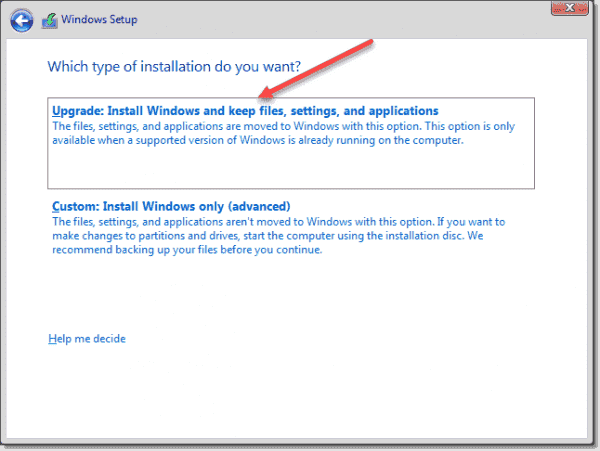
Choosing an upgrade for blazon of installation
Subsequently you lot click the Upgrade option, you lot volition see the normal Windows installer screens that retain your settings and update your Windows Server installation. Your server will reboot several times.
Once the upgrade process has completed, you lot will see the freshly upgraded Windows Server 2012 R2 installation. It should contain your previous apps, data, and settings.
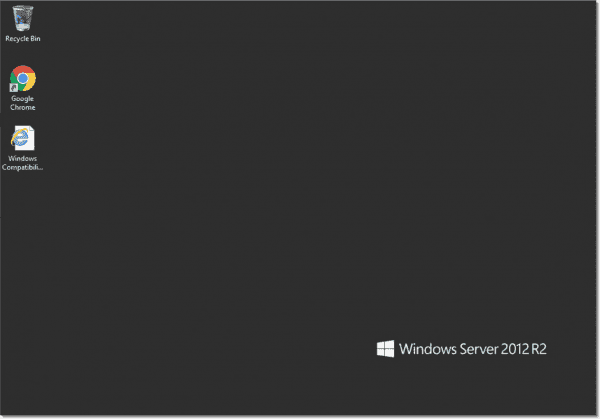
Windows Server in place upgrade to Windows Server 2012 R2 is successful
At present, if Windows Server 2012 R2 is not your final destination, you will need to perform another in-identify upgrade to reach your target Windows Server version.
Equally you think, we have to perform this aforementioned procedure over again to get from Windows Server 2012 R2 upward to Windows Server 2019. Afterwards mounting the Windows Server 2019 install media on the newly upgraded Windows Server 2012 R2 server, we run the upgrade again. The installer will prompt you to download updates to the installer itself.

Starting the Windows Server 2019 upgrade in Windows Server 2012 R2
You will demand to enter a valid Windows Server 2019 license key and also select the Windows Server 2019 paradigm you would like to install.
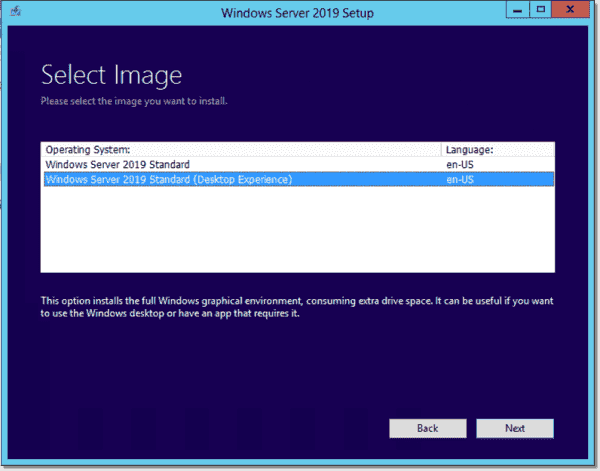
Cull the Windows Server 2019 paradigm you want to upgrade to
The wording of the upgrade vs. clean install with the Windows Server 2019 installer is a chip less obvious. On the Choose what to keep page, select Continue personal files and apps for an upgrade. Select Zippo if you want to perform a clean installation.
You will want to cull the first option for an upgrade.

Choose between an upgrade and clean install with Windows Server 2019 installer
The upgrade is fix to proceed with keeping your files and applications.
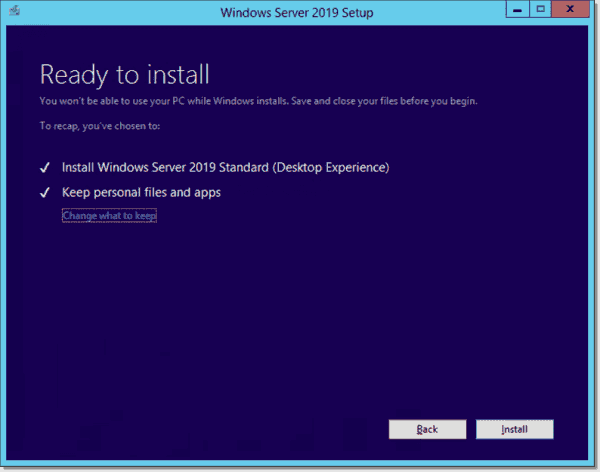
Ready to upgrade to Windows Server 2019
Only as with the upgrade to Windows Server 2012 R2, the server will reboot several times. Later a short fourth dimension, your server should successfully upgrade to Windows Server 2019.
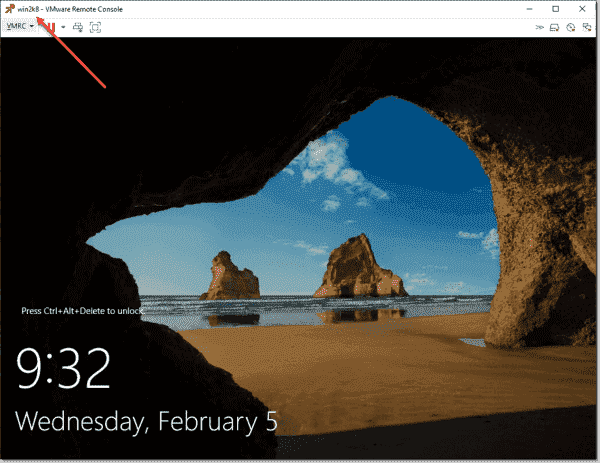
Windows Server 2008 R2 successfully upgraded to Windows Server 2019
Decision ^
With the end of support from Microsoft for Windows Server 2008/2008 R2 reached every bit of January fourteen, 2020, moving product workloads off Windows Server 2008/2008 R2 should be a priority. While there are several ways to move your workloads to newer versions of Windows Server, the in-place upgrade may be the best option for those who want to go along their server on-premises and who take many custom applications, settings, and data that would be difficult to migrate to a different server.
The Windows Server 2008/2008 R2 in-place upgrade to Windows Server 2019 involves two in-place upgrades: i to Windows Server 2012 R2 and then an upgrade from 2012 R2 to Windows Server 2019. All in all, the process is straightforward and should be like shooting fish in a barrel to attain with planned downward time.
![]()
![]()
Source: https://4sysops.com/archives/windows-server-2008-2008-r2-in-place-upgrade-to-windows-server-2019/
Posted by: riveracomman1999.blogspot.com

0 Response to "How To Upgrade Windows 2008 R2 To Windows 2019"
Post a Comment